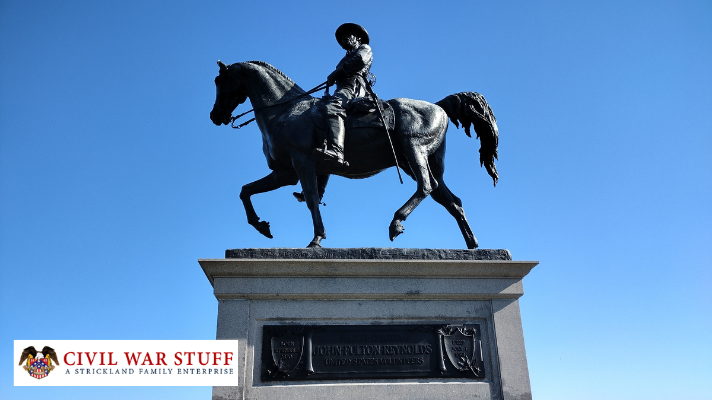General John Reynolds

Lancaster, PA, native John Fulton Reynolds was born in 1820. His birthplace of Lancaster is a mere hour and fifteen minutes away from the battlefield, where Reynolds would ultimately lose his life. Reynolds graduated West Point in 1841, number 26 in his class of 50. He would spend the next four years of his career in the artillery.
As his military career progressed, Reynolds found himself in the Mexican War. Eventually, in 1860 he was assigned as Commandant of the Cadets at West Point. At the onset of the War between the States, Reynolds became a brigadier general. In 1862, he was captured behind Confederate lines while commanding the 1st Brigade of Pennsylvania Reserve.
Thanks to a prisoner exchange in August of 1862, Reynolds returned to the battlefield commanding a division at Second Bull Run. He was summoned to Washington after the Battle of Chancellorsville for a meeting with President Lincoln. Reynolds was believed to be offered command of the Union Army during that meeting. However, Reynolds turned the assignment down because he felt he would be second-guessed by Washington, the same as previous commanders had been.
Reynolds at Gettysburg
As the Gettysburg battle unfolded on July 1, 1863, Reynolds was in command of the army’s left wing consisting of the 1st, 3rd, and 11th Corps. The action began near an unfinished railroad cut along the Chambersburg Pike. The infamous Iron Brigade pushed forward from this location towards the Herbst Woods on McPherson’s Ridge.
Reynolds fund himself and his men in the thick of the fight. Mounted on his horse, issuing orders, Reynolds made for an easy target. As troops rushed past Reynolds into the woods, Reynolds could be heard shouting, “Forward men, forward, for God’s sake, and drive those fellows out of the woods.”
As both armies exchanged heavy gunfire, Reynolds, exposed on his mount, was hit in the back of the neck by a bullet and killed instantly.
After the Battle
The equestrian statue is one of 3 monuments on the Gettysburg battlefield of Reynolds. The other two are located at the position where Reynolds was mortally shot and in the National Cemetery. Henry Kirke Bush-Brown sculpted this statue. He was also responsible for the Meade and Sedgwick equestrian statues as well as the bust of Lincoln in the Lincoln Speech Memorial. The statue was dedicated in 1899.
This statue also notably showcases the long-held rumor that if a horse has two feet off the ground, it indicates the rider was killed during the battle.








